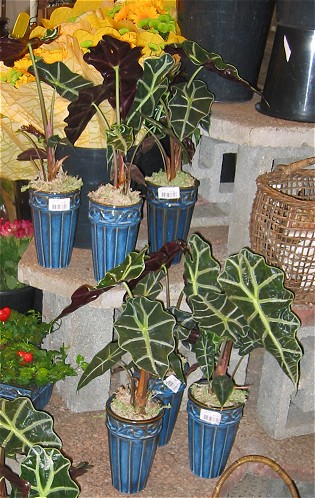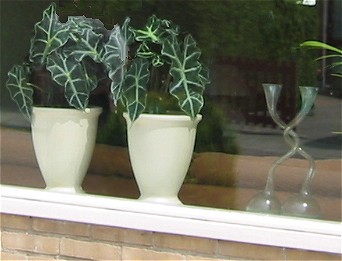

|
Alocasia amazonica (de laatste jaren nogal in de mode) is waarschijnlijk een vrij nieuwe kamerplant in Nederland, want in mijn plantenboeken kon ik 'm niet vinden. Ik weet dan ook niet hoe hij in onze taal zou moeten heten.
De Engelse naam kwam ik toevallig ergens op 't Internet tegen. De donkergroene bladeren met zilverwitte nerven zien er bijna uit alsof ze van plastic zijn, de eerste keer dacht ik even met een kunstplant te maken te hebben. Toch zijn de bladeren minder stevig dan ze eruitzien en bovendien vrij kwetsbaar. Op bovenstaande foto, genomen in de gemeentekas te Beetsterzwaag in Friesland, ziet men ook enige bruine vlekjes op het blad door uitdroging of beschadiging anderzijds. Deze plant is verwant aan Alocasia cuprea, die ik bij een vriendin thuis heb gefotografeerd. Naast Alocasia schijnt voor dezelfde planten ook de naam Colocasia in gebruik te zijn. Beide worden ook aangeduid als "taro". Van de wortelstokken wordt een eetbaar en/of stijfselachtig product gemaakt in de tropen, met name van Colocasia esculenta, ook wel yam genoemd.  | Alocasia amazonica, called the African mask, probably is a relatively new houseplant in the Netherlands, I couldn't find it anywhere in my books about plants. But lately I came across it on the Internet,
so I'm lucky enough to know its name. It has darkgreen leaves with silver-white veins, looking like plastic. The first time I saw one, I even thought it was an artificial plant. Though the leaves may look strong, they are quite vulnerable really, and they don't feel like plastic. In the above photo, taken in a greenhouse belonging to the town of Beetsterzwaag in the province of Friesland in the north of the Netherlands, you see some brown spots on these leaves, they're damaged easily. The plant is related to Alocasia cuprea, of which I took some photos at a friend's home. Beside Alocasia the name Colocasia seems to be used for the same plant genus. Both are associated with the common name "taro", about the starchy and food products that can be prepared from the rhizomes, mainly from Colocasia esculenta, also called "yam".  Links een aantal Alocasia-planten in een bloemenwinkel, hierboven een "tweeling" in een vensterbank (zoals dat tegenwoordig - 2003 - de grote mode is) On the left some Alocasia plants in a flowershop, in the picture above twin pots with Alocasias, which is trendy nowadays (2003) Zie mijn eigen Alocasia / See my own Alocasia |

